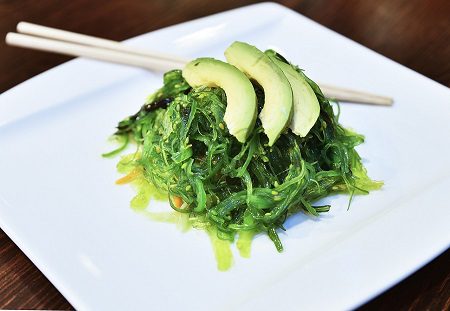OK I love seaweed and have been seeing studies about the nutritional benefits, so I thought I’d share. Having long been a staple in many cultures, seaweed is nutrient dense, it’s sustainable, has low environmental impact, and has a yummy umami flavor.
The protein in seaweed is complete meaning that it’s one of few plant foods that contain all nine essential amino acids. It contains many antioxidants in the form of vitamins (A, B, C, and E), protective pigments, and it includes minerals like iodine, calcium, magnesium and potassium.
According to Tufts University Health & Nutrition Letter, two large studies conducted in Japan recently reported an association between seaweed intake and lower risk of cardiovascular disease.
There are 100 types of edible seaweed. Some of the most popular types of seaweed include nori, kelp/kombu, and wakame.
Nori
Think of nori as a beginner’s seaweed. You can find it in sushi rolls and sheets as “seaweed snacks.” Grab a sheet of nori, add a spoonful of warm rice and a slice avocado and you have a flavorful snack (dip in soy sauce if you so desire).
Kombu
A member of the kelp family, kombu is a seaweed that makes for a versatile pantry ingredient, providing dishes with umami flavor,
Kombu can be used to make dashi, a light vegetarian broth used as a base for dishes like miso soup and ramen. Add this kelp to Asian soups or cut up and add to a salad.
Wakame
Wakame is one of the major types of edible seaweed most commonly seen floating in miso soup or as a seaweed salad in Japanese restaurants. It can be served in other soups, chopped and added to salads, or as a side dish to seafood.
Wakame comes dry and needs to be rehydrated before using.
Where to buy. Seaweed items can be found in Asian markets, healthier stores, and sometimes on the international isle of local supermarkets. The last time I visited Trader Joe’s they carried nori sheets and seaweed flakes (furikake).
All in moderation. Seaweed is a natural source of iodine which is necessary for proper bodily function but should be eaten only a couple times per week. As with anything, eat a diet that has a variety of nutritional food types and consult a nutritionist for specifics.
More About seaweed:
Savoring Seaweed. Tufts University Newsletter
What Is Wakame? The Spruce Eats
What Is Kombu? How do you use it? Thekitchen.com
Nutritional and digestive health benefits of seaweed. National Library of Health
Visit my Resources page for more inspiration on living your healthiest life.

